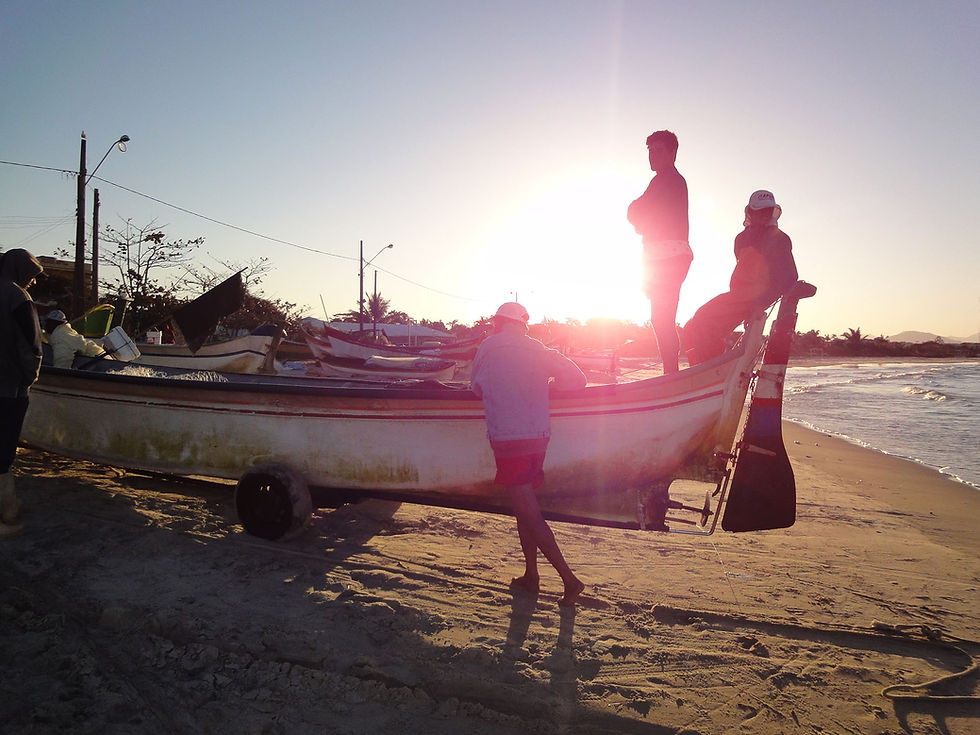
Women & the sea
Sapphires of the Fishery
By Rose Mary Gerber – PhD in Social Anthropology

Iliete
Iliete, from Itapoá, on the northern coast of Santa Catarina, is convinced that: “The big step in our lives was that I had the courage to get financing. The first time was difficult because they didn't want to do it for a woman. They claimed women don't fish. How will she pay? But I did it, and I paid it off!”
Josi
Josi, a fisherwoman who works with her brothers and uncles in Armação do Pântano do Sul, Florianópolis: “Fishing is an area that has challenges, and for me, the more challenges the better. The more they say it can't be done, the more I go there and do it.”

Mãezinha
Mãezinha (Little Mother), São Francisco do Sul: “I'm known as Mãezinha. Even my boat is named Mãezinha. I love life on the sea. I want to die in it. I am proud to be a fisherwoman and live the life I live, and later, my grandchildren will say: my grandmother was a fisherwoman.”


Adriana
Adriana, Barra do Sul: “Since I was little, my father would go fishing and I wanted to go along. I started. I grew up, learning. Today, I fish with my husband. Fishing must be done by two. Life in fishing is freedom, it's the open air, nature—something many people don't have.”
Naca
Naca: lives in Cantos dos Ganchos, Governador Celso Ramos: “My mother used to put my father’s clothes on me because I didn't have clothes to fish in. I was the eldest daughter and, in that poverty, I had to go, I had to do it. Yes, I like fishing. I am Naca. A real fisherwoman!”


Tansinha rests
A companion in chores, departures, and returns; without a boat, there is no fishing. While the work on land is done, she stays, quiet, waiting for the next move.
Dona Si
Dona Si, Barra do Sul. The hands that age in fishing are creased, marked by the sun and daily toils: “I've always worked in fishing. Me, my husband, my sons, and my daughters-in-law. I grew old fishing.”


Signaling flags
The fishing world has its own organization, of which the flags are a part, signaling whose "fishing spot" it is. Everyone knows which flag is theirs.
Arriving on land
Returning from the sea is not just about completing a day's task, but knowing you are alive, enjoying the safety of one who has returned.


The researcher and the sea
I learned a lot from the fisherwomen, but also from the sea. I learned that it dictates if we go out and when we return. A fascinating world, this fishing world, of fishermen and fisherwomen.
Credits
Exhibition: Women and the Sea: Sapphires of the Fishery
Rose Mary Gerber
Ph.D. in Social Anthropology
Authorship and Curation
Ticiano Alves
Exhibition Coordinator
EXEA Maritime Museum
Layout and Design
Ocean's Embrace
MusicGen Envato
Ambient Music
Leandro Vilar
General Director
EXEA Maritime Museum
Camila Rios
Technical Director | Museologist
EXEA Maritime Museum
Raphaella Belmont Alves
Executive Director | Proofreader
EXEA Maritime Museum
Exhibition Review
© All rights reserved.
Legal Review

Introduction
"Women and the Sea: Sapphires of the Fishery" is Part II of the exhibition "Women and the Sea," resulting from my doctoral research in Social Anthropology at UFSC (Federal University of Santa Catarina) in 2013, which dissertation was adapted into the book "Women and the Sea." My fieldwork lasted 11 months, during which I traveled the coast of Santa Catarina, Southern Brazil, participating in the daily lives of professionals who call themselves "women of courage" (mulheres de valentia). The purpose was to capture the intricacies of how they construct their identities and recognize themselves as fisherwomen.
Safira, with whom I spent the most time, was the focus of Part I of the exhibition. Since "safira" (sapphire) is not only a proper name but also a gemstone, I chose this name for Part II of the exhibition: "Sapphires of the Fishery." I see these women as precious gems with whom I had the opportunity to live, learn, and share stories and memories about life's knowledge and practices (saberes-fazeres). The fisherwomen I met work with husbands, sons, brothers, sons-in-law, and daughters. They are their "comrades." In some cases, they are the captains of the small vessels they use to travel.
Most were initiated into fishing very early by their fathers, between 8, 9, and 10 years old, in trajectories marked by economic difficulties—"poverty." Usually the eldest daughters. Others asserted themselves in fishing, even when their parents did not want them to go to sea. From a young age, they were driven by curiosity to know what it was like to fish. Others had their husbands as mentors. Some were, themselves, the mentors to their husbands. Each one told me they "got used to" the activity; or that it is "the only thing" they know how to do. In common, they shared laughter, good humor, and jocoseness, combined with expressions like "liking, loving, having a passion, an addiction" for life on/of the sea.
